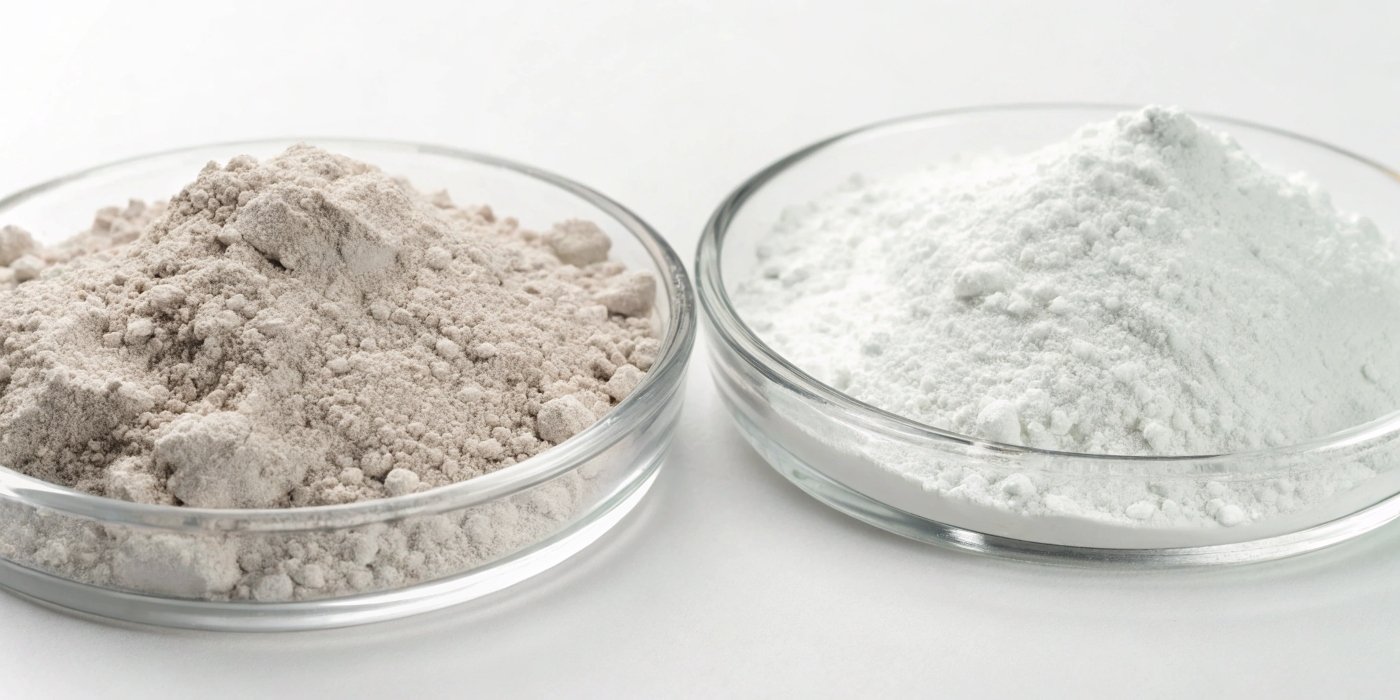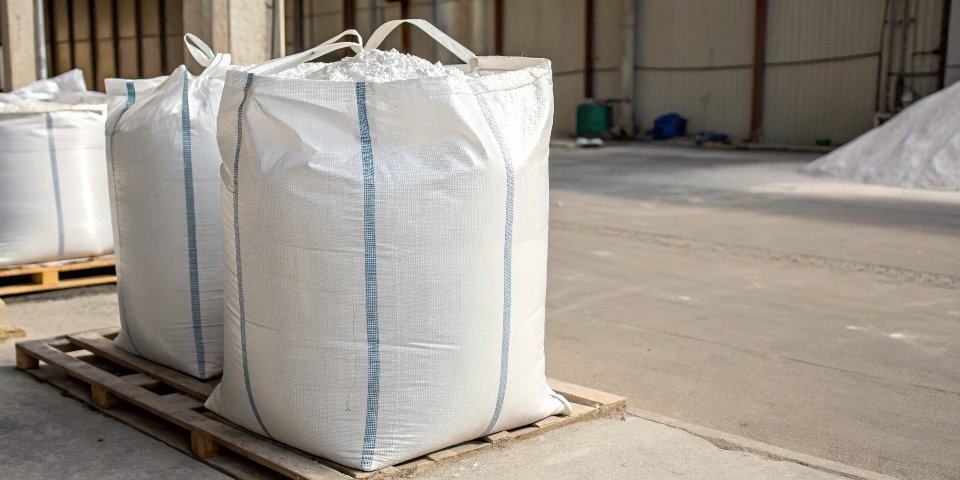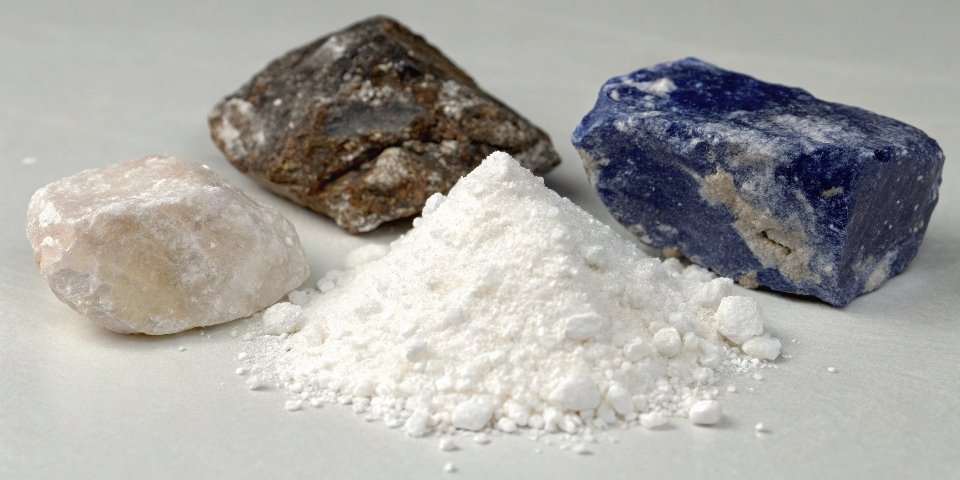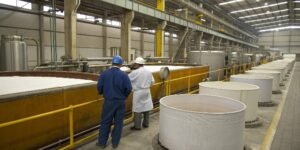
Are you trying to source an aluminum compound but confused by the names? Using aluminum oxide when you need aluminum hydroxide can lead to production failures and costly mistakes.
No, they are fundamentally different chemicals. Aluminum hydroxide (Al(OH)₃) is a hydrated compound used as a flame retardant. It is heated (calcined) to remove water and create aluminum oxide (Al₂O₃), a very hard material used for abrasives and ceramics.

As someone who manages the production of aluminum hydroxide at our plant, I see this confusion often. Both materials arrive as fine white powders, making them look identical. However, their chemical structures and physical properties could not be more different. This difference is everything when it comes to their performance in a final product. Understanding this relationship is the first step to sourcing the right material for your specific application.
What is the key difference between aluminum hydroxide and aluminum oxide?
You see two white powders that both contain aluminum. They might seem interchangeable. But using one in place of the other can cause a product to fail completely.
The key difference is their chemical composition. Aluminum hydroxide (Al(OH)₃) contains chemically bound water molecules. Aluminum oxide (Al₂O₃), also known as alumina, does not. This is a result of a heating process that fundamentally changes the material’s properties.

From my factory floor perspective, this difference is the most important concept in our business. Aluminum hydroxide is the precursor material. We produce it with specific properties. Some of our customers use it directly. Others rely on its ability to transform into aluminum oxide. The chemical equation for this transformation is simple: 2Al(OH)₃ + Heat → Al₂O₃ + 3H₂O. When aluminum hydroxide is heated to over 200°C, it starts to decompose, releasing water vapor and converting into alumina. This process, called calcination, creates a much harder and more thermally stable material.
| Feature | Aluminum Hydroxide | Aluminum Oxide |
|---|---|---|
| Chemical Formula | Al(OH)₃ | Al₂O₃ |
| Key Property | Releases water when heated | Extremely hard and thermally stable |
| Main Use | Flame retardant, antacid | Abrasives, ceramics, refractories |
| Mohs Hardness | 2.5 – 3.5 | 9 |
| Decomposition | Starts at ~200°C | Melts at ~2072°C |
This table clearly shows they are used for completely different purposes because of their different properties. One puts out fires, while the other can be used to grind steel.
What is another name for aluminum hydroxide?
You are reading a technical data sheet and see the term "ATH" or "hydrated alumina." This naming confusion can delay procurement or cause you to order the wrong product.
Yes, these are common industrial names for the same chemical. Aluminum hydroxide is most often called ATH, which stands for Alumina Trihydrate. It is also referred to as hydrated alumina.

In the industry, we rarely use the full chemical name. We almost always call it ATH. This name can be a little confusing, but it comes from an older way of writing the chemical formula.
Breaking Down The Names
- ATH (Alumina Trihydrate): This is the most common industry term. The name comes from viewing the compound as an alumina1 molecule (Al₂O₃) combined with three water molecules (3H₂O). The empirical formula
Al₂O₃·3H₂Ois the same as2Al(OH)₃. The "trihydrate" part refers to the "three waters." It’s just industrial shorthand. When a buyer requests ATH, I know exactly what they need. - Hydrated Alumina: This is a more descriptive name. It literally means "alumina with water." This name helps to logically connect it to aluminum oxide2 (alumina) by highlighting the water content as the key difference.
- Gibbsite3: This is the mineral name for aluminum hydroxide. Bauxite ore, the source of all aluminum, is primarily composed of gibbsite. As a producer, we essentially refine bauxite into a purified, man-made form of gibbsite with controlled particle sizes for industrial use.
What is another name for aluminium oxide?
You hear about alumina in one context, and corundum in another. This can make it seem like they are different materials, causing confusion about what to buy for a high-performance application.
The most common industrial name for aluminum oxide is simply alumina. In its natural crystal form, it is called corundum. Gem-quality versions of corundum are also known as ruby and sapphire.

After we calcine our aluminum hydroxide, the resulting white powder is what the entire world calls alumina. This is the foundational material for a huge range of products that require hardness, heat resistance, or chemical inertness. But this one chemical takes on different names depending on its form and use.
Understanding the Aliases
- Alumina: This is the standard name used for the synthetic white powder in all industrial applications, from making spark plugs to producing aluminum metal.
- Corundum: This is the name for the natural crystalline form of aluminum oxide. Corundum is famous for its incredible hardness, rating a 9 on the Mohs scale. This is why it is crushed and used to make sandpaper and grinding wheels.
- Ruby and Sapphire: These precious gems are just special forms of corundum4. They are not different chemicals. Their brilliant colors come from tiny amounts of metal impurities in the crystal structure. Chromium gives ruby its red color, while iron and titanium give sapphire its blue color.
- Activated Alumina: This is a special, porous form of alumina. It is processed to have a very high surface area, making it excellent at absorbing water. It is widely used as an industrial desiccant to dry air and other gases.
Conclusion
Aluminum hydroxide and aluminum oxide are not the same. The hydroxide (ATH) contains water and is the precursor to the hard, water-free oxide, known as alumina, which is produced by heating.
-
Learn about alumina, its properties, and its importance in industrial applications. ↩
-
Learn about the diverse applications of aluminum oxide, especially in abrasives and ceramics. ↩
-
Find out about Gibbsite, its role in aluminum production, and its properties. ↩
-
Explore the natural form of aluminum oxide, corundum, and its uses in various industries. ↩
You may also be interested in:

How is sodium hydroxide used in the paper industry?
Paper production is a complex process. Using the wrong chemicals can ruin pulp quality and increase costs. Sodium hydroxide is a key chemical that solves many of these challenges. Sodium

What Are the Core Properties and Production Methods of Aluminum Hydroxide?
Finding reliable aluminum hydroxide is hard. Inconsistent quality can ruin your products. Let’s explore its core properties and how it’s made, so you can source with confidence. Aluminum hydroxide is

China Low Viscosity Aluminum Hydroxide Manufacturers?
Are you tired of searching for direct aluminum hydroxide factories in China? The process can be confusing, and you might be dealing with traders who raise prices. The most prominent

Is Al(OH)3 a solid, liquid or a gas?
Are you confused about the basic physical state of aluminum hydroxide? This uncertainty can cause problems in handling and application. Let’s clear up this fundamental question right away. Aluminum hydroxide,

Aluminum Trihydrate (ATH) Supplier in India?
Finding reliable suppliers in a vast market can be overwhelming. Do you risk quality for cost or balance both? India offers several qualified Aluminum Trihydrate (ATH) suppliers known for quality

Aluminium Trihydrate Manufacturers Suppliers New Delhi?
Looking for reliable aluminium trihydrate sources in New Delhi can be overwhelming. The quality and delivery times vary. How can you find the right supplier? To find aluminium trihydrate manufacturers

Aluminium Hydroxide at Lowest Price in Bhavnagar?
Finding affordable aluminum hydroxide seems challenging, right? Manufacturers often struggle with cost, but there are ways to secure competitive prices in Bhavnagar. The best way to get low prices on

How is sodium hydroxide used in the paper industry?
Papermaking needs pure pulp, but lignin makes it weak and yellow. How do you fix this? Sodium hydroxide is the essential chemical that effectively removes these unwanted impurities. Sodium hydroxide,

Properties and Production of Aluminium Hydroxide?
Are you struggling to find a consistent, high-quality supply of aluminum hydroxide? Price fluctuations and unreliable quality from middlemen can harm your business and disrupt your production schedule. Aluminum hydroxide

How is Fine Aluminum Hydroxide Precipitated from Bayer Liquors?
Struggle with inconsistent aluminum hydroxide? Worried that poor particle size will compromise your product quality? We master the precipitation process to deliver the fine, consistent powder you require. To precipitate